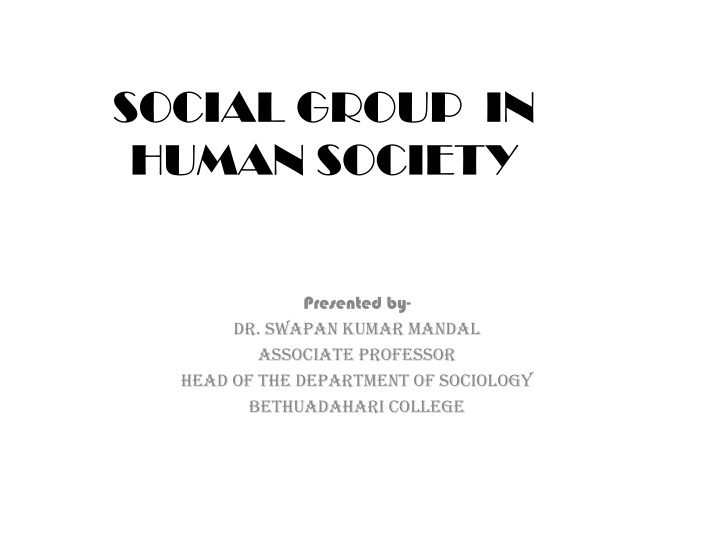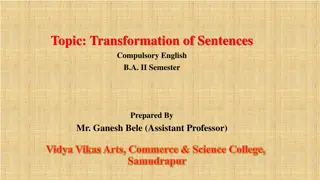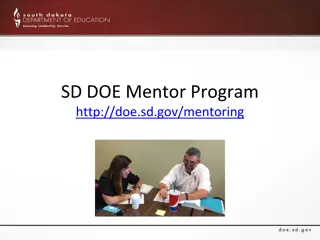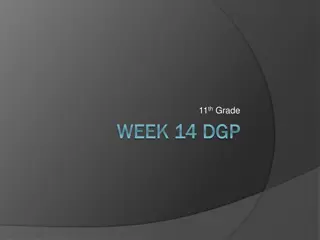Mentor Sentence Journey
Engage in a week-long mentor sentence exploration where you analyze, compare, imitate, revise, and share inspiring quotes. Discover the power of punctuation, word choice, and structure. Collaborate with peers to enhance your writing skills.
Download Presentation

Please find below an Image/Link to download the presentation.
The content on the website is provided AS IS for your information and personal use only. It may not be sold, licensed, or shared on other websites without obtaining consent from the author.If you encounter any issues during the download, it is possible that the publisher has removed the file from their server.
You are allowed to download the files provided on this website for personal or commercial use, subject to the condition that they are used lawfully. All files are the property of their respective owners.
The content on the website is provided AS IS for your information and personal use only. It may not be sold, licensed, or shared on other websites without obtaining consent from the author.
E N D
Presentation Transcript
SOCIAL GROUP IN HUMAN SOCIETY Presented by- Dr. Swapan Kumar Mandal Associate Professor Head of the Department of Sociology BETHUADAHARI COLLEGE
CONTENTS 1. 2. 3. 4. A) B) C) 5. A) B) C) 6. Difference between Primary Group and Secondary Group Definition of Social Group Characteristics of Social Group Types of Social Group Primary Group Definition of Primary Group Characteristics of Primary Group Role of Primary Group in Human Society Secondary Group Definition of Secondary Group Characteristics of Secondary Group Role of Secondary Group in Human Society
Definition of Social Group R.M.MacIver & C.H.Page .by group we mean any collection of human beings who are brought into social relationship with another. Social relationship involve, as we have seen, some degree of reciprocity between those related, some measures of mutual awareness as reflected in the attitude of the members of the group. P.Gisbert A social group is a collection of individuals inter acting on each other under a recognizable structure. Example: Family, Village, Political Party, Social Class, etc.
CHARACTERISTICS OF SOCIAL GROUP i) ii) iii) iv) v) vi) vii) viii) Creation of institutional structure ix) We-feeling x) Role in the development of personality xi) Own rules and regulations xii) Carrier of social culture Existence of social relation Sense of collectiveness Sense of group consciousness Collective understanding among its members Coercion on its members Changeable not stable or static Property
TYPES OF SOCIAL GROUP 1) 2) 3) 4) 5) 6) 7) 8) 9) Primary Group & Secondary Group In-Group & Out-Group Permanent Group & Temporary Group Vertical Group & Horizontal Group Formal Group & Informal Group Voluntary Group & Involuntary Group Dyad Group & Triad Group Community & Association Reference Group
PRIMARY GROUP Definition : C.H.Cooley : Primary Group . Characterised by face to face association and co-operation. P. Gisbert : The Primary or face to face group is based on direct personal Contact , in which the members deal immediately with one another .
CHARACTERISTICS OF PRIMARY GROUP 1 ) Physical Proximity 2) Small Size 3) Stability 4) Identity of Ends 5) Intrinsic Value of Relationship 6) Personal Relationship 7) Inclusive Relationship 8) Similarity of Background 9) Intensity of Shared Interest 10) Spontaneous Relationship
ROLE OF PRIMARY GROUP IN HUMAN SOCIETY 1. 2. 3. 4. 5. 6. 7. 8. 9. 10. Create Opportunity of Direct Co-operation Socialization Development of Personality Helps to fulfill the Objectives of Big/Large Organization Give close proximity Solve Social, Physical and Mental Problem Development of Emotional Characteristics Solve the Problem of Self-centeredness and Jealousness Create Opportunity to meet each other spontaneously Inspire its Members in all Activities
SECONDARY GROUP DEFINITION : According to Prof. Kingsley Davis Secondary Groups can be roughly defined as the opposite of everything said about Primary Groups . Prof. P. Gisbert said ..the secondary group . rests on indirect, secondary or categorical contacts. People may not know each other personally. . The relations , which before were personal and primary as mentioned above , now become impersonal , secondary and formal .
CHARACTERISTICS OF SECONDARY GROUP 1. 2. 3. 4. 5. 6. 7. 8. 9. 10. All members are not equally active Large Size Voluntary Membership Status of Person depends on his/her Role Non -existence of face to face Relation Objectives of Group is main Relationship controlled by contract Indirect and impersonal relationship Indirect co-operation Group may dissolve after completion of the objective
ROLE OF SECONDARY GROUP IN HUMAN SOCIETY 1. Scope of opportunity increased 2. Development of Skill 3. Help in the development of Personality 4. Develop Liberal Attitude
DIFFERENCE BETWEEN PRIMARY GROUP & SECONDARY GROUP PRIMARY GROUP SECONDARY GROUP Sl.No. Basis of Difference Subject Matter Subject Matter 1. Size Small Size Large/Big Size 2. Formality Informal Formal & Organized 3. Co-operation Direct Co-operation Indirect Co-operation 4. Relationship Personal Impersonal 5. Relationship Spontaneous Non-spontaneous 6. Relationship Face to Face Relation Lack of Face to Face Relation
Continued Sl.No . Basis of Difference Primary Group Secondary Group 7. Relationship Relation is Important Objective is Important 8. Background Similar Background Dissimilar Background 9. Contract Contract is not important Relationship is controlled by Contract 10. Stability Comparatively more Stable Lack of Stability 11. Membership Involuntary Voluntary 12. Interest Common interest encompassing whole life Centered on Special Interest 13. Objective Unlimited Objectives Limited Objective 14. Role Role for Development of Personality No Role for Development of Personality























